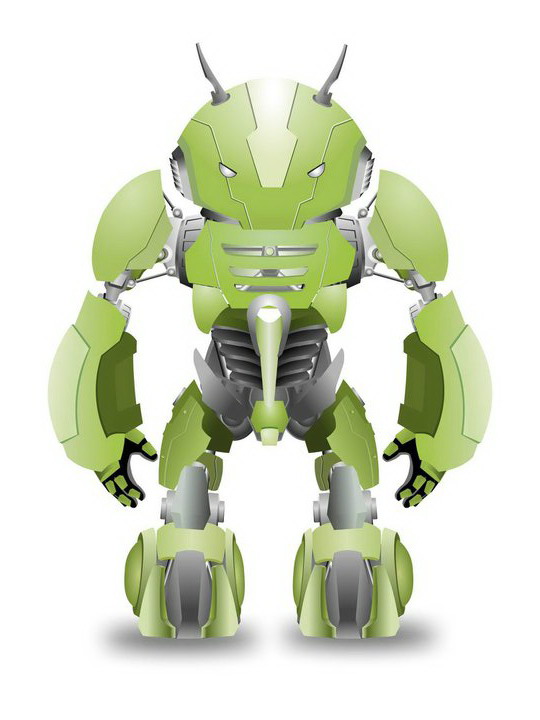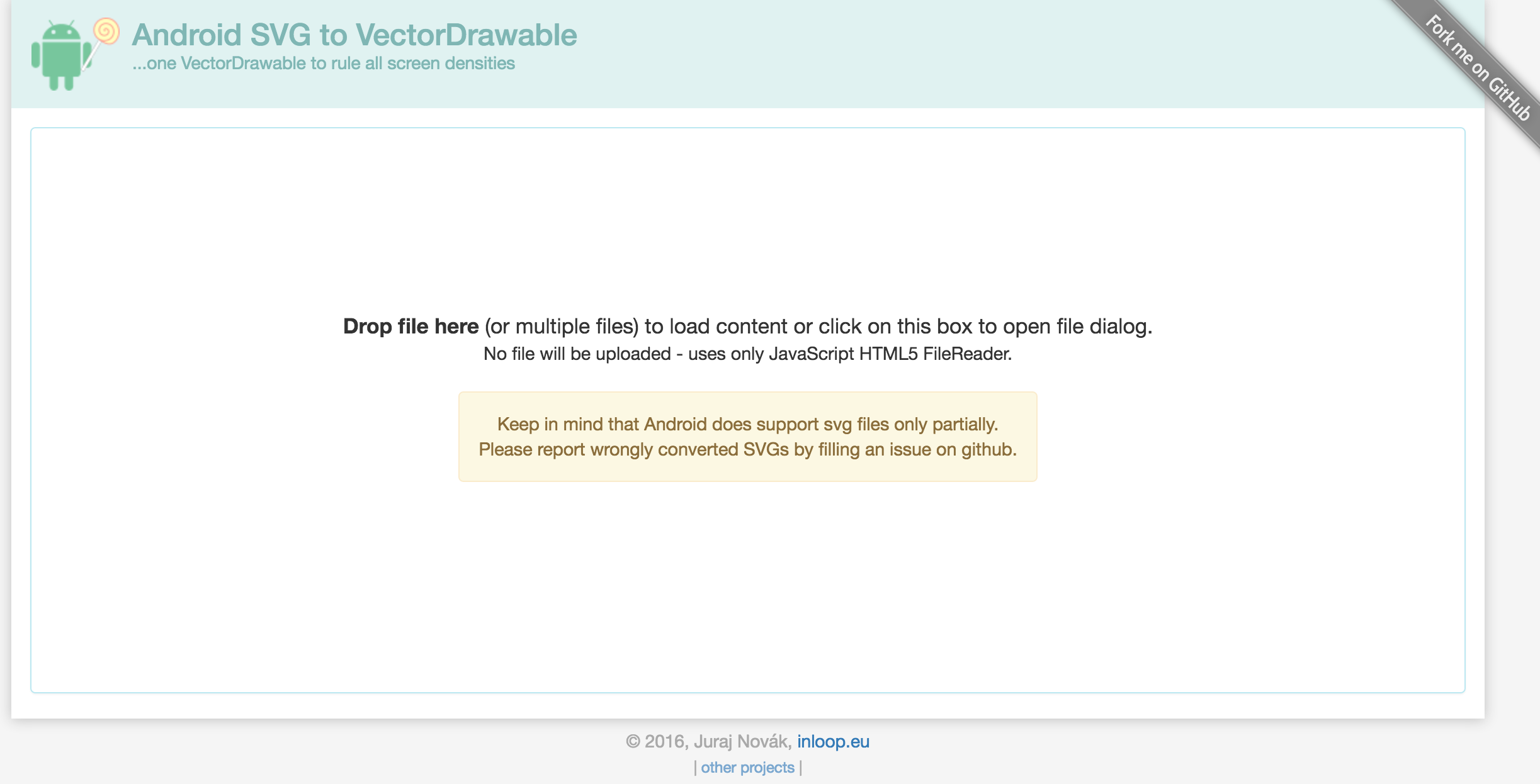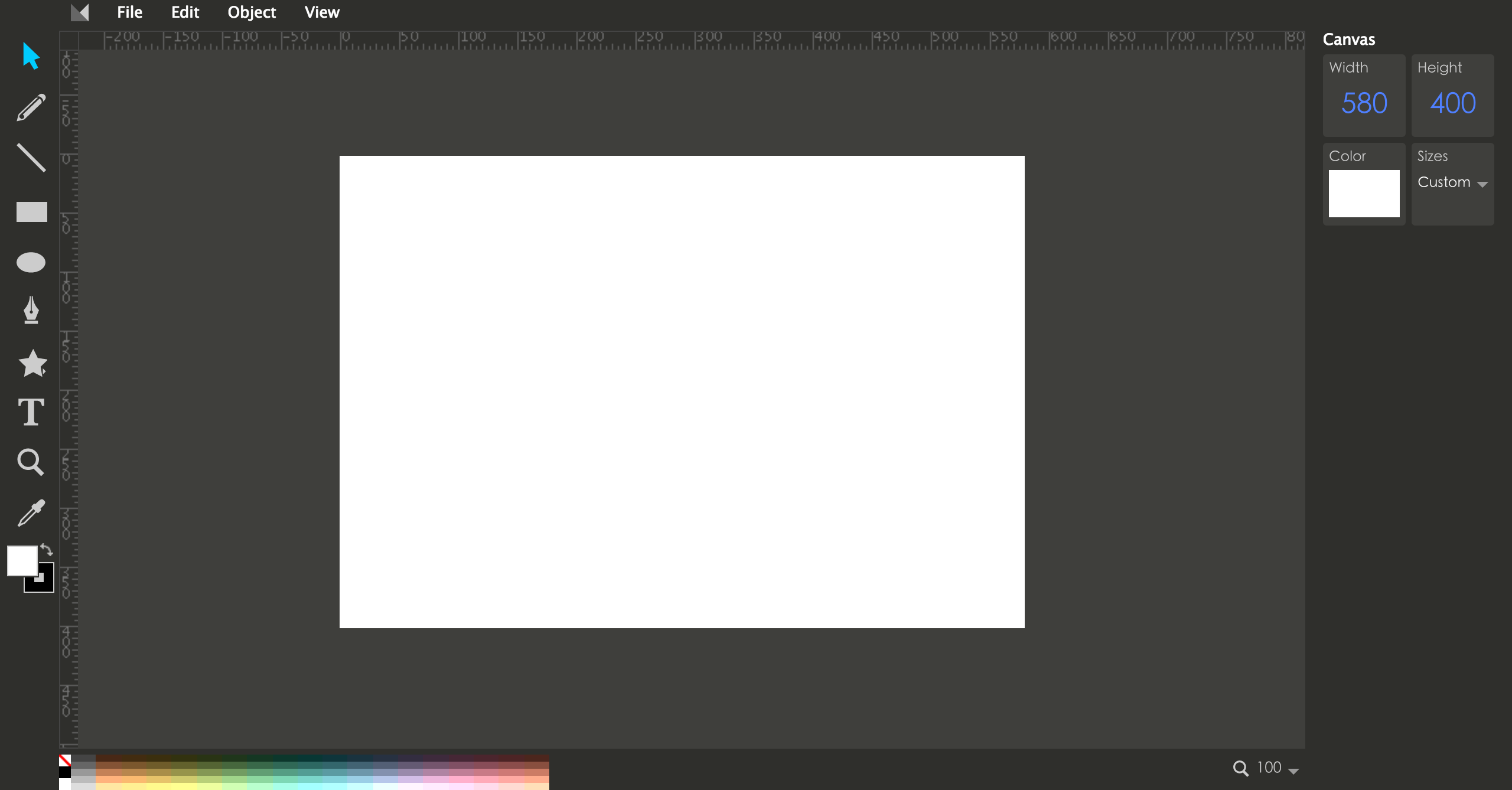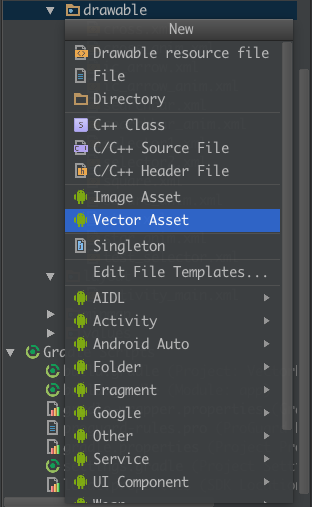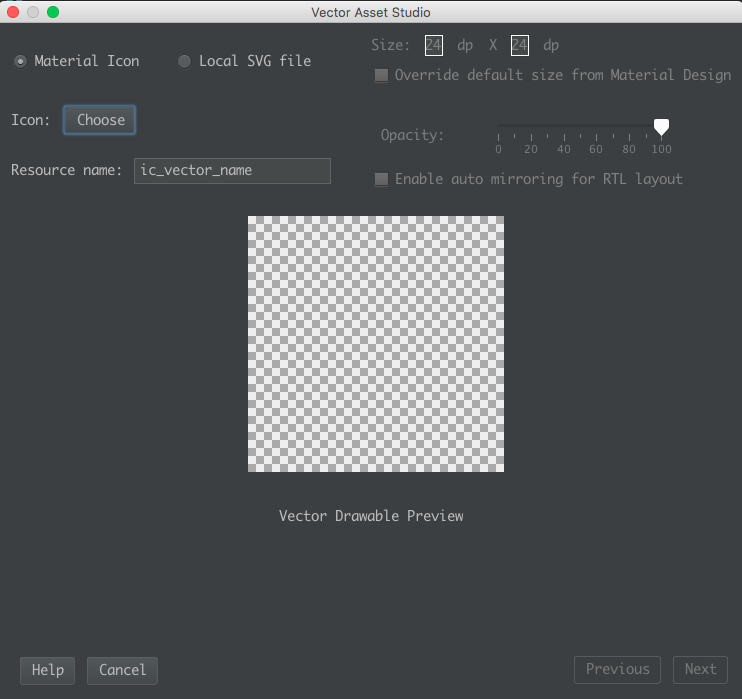Android Vector曲折的兼容之路
两年前写书的时候,就在研究Android L提出的Vector,可研究下来发现,完全不具备兼容性,相信这也是它没有被广泛使用的一个原因,经过Google的不懈努力,现在Vector终于迎来了它的春天。
在文章后面,会给出本文的Demo和效果图,并开源在Github
Vector Drawable
Android 5.0发布的时候,Google提供了Vector的支持。Vector Drawable相对于普通的Drawable来说,有以下几个好处:
- Vector图像可以自动进行适配,不需要通过分辨率来设置不同的图片
- Vector图像可以大幅减少图像的体积,同样一张图,用Vector来实现,可能只有PNG的几十分之一
- 使用简单,很多设计工具,都可以直接导出SVG图像,从而转换成Vector图像
- 功能强大,不用写很多代码就可以实现非常复杂的动画
- 成熟、稳定,前端已经非常广泛的进行使用了
Vector图像刚发布的时候,是只支持Android 5.0+的,对于Android pre-L的系统来说,并不能使用,所以,可以说那时候的Vector并没有什么卵用。不过自从AppCompat 23.2之后,Google对p-View的Android系统也进行了兼容,也就是说,Vector可以使用于Android 2.1以上的所有系统,只需要引用com.android.support:appcompat-v7:23.2.0以上的版本就可以了,这时候,Vector应该算是迎来了它的春天。
如何获得Vector图像
概念
首先,需要讲解两个概念——SVG和Vector。
SVG,即Scalable Vector Graphics 矢量图,这种图像格式在前端中已经使用的非常广泛了,详见WIKI:https://en.wikipedia.org/wiki/Scalable_Vector_Graphics
Vector,在Android中指的是Vector Drawable,也就是Android中的矢量图,详见:https://developer.android.com/reference/android/graphics/drawable/VectorDrawable.html
因此,可以说Vector就是Android中的SVG实现,因为Android中的Vector并不是支持全部的SVG语法,也没有必要,因为完整的SVG语法是非常复杂的,但已经支持的SVG语法已经够用了,特别是Path语法,几乎是Android中Vector的标配,详细可以参考:http://www.w3.org/TR/SVG/paths.html
Vector语法简介
Android以一种简化的方式对SVG进行了兼容,这种方式就是通过使用它的Path标签,通过Path标签,几乎可以实现SVG中的其它所有标签,虽然可能会复杂一点,但这些东西都是可以通过工具来完成的,所以,不用担心写起来会很复杂。
Path指令解析如下所示:
-
支持的指令:
- M = moveto(M X,Y) :将画笔移动到指定的坐标位置
- L = lineto(L X,Y) :画直线到指定的坐标位置
- H = horizontal lineto(H X):画水平线到指定的X坐标位置
- V = vertical lineto(V Y):画垂直线到指定的Y坐标位置
- C = curveto(C X1,Y1,X2,Y2,ENDX,ENDY):三次贝赛曲线
- S = smooth curveto(S X2,Y2,ENDX,ENDY)
- Q = quadratic Belzier curve(Q X,Y,ENDX,ENDY):二次贝赛曲线
- T = smooth quadratic Belzier curveto(T ENDX,ENDY):映射
- A = elliptical Arc(A RX,RY,XROTATION,FLAG1,FLAG2,X,Y):弧线
- Z = closepath():关闭路径
-
使用原则:
- 坐标轴为以(0,0)为中心,X轴水平向右,Y轴水平向下
- 所有指令大小写均可。大写绝对定位,参照全局坐标系;小写相对定位,参照父容器坐标系
- 指令和数据间的空格可以省略
- 同一指令出现多次可以只用一个
注意,’M’处理时,只是移动了画笔, 没有画任何东西。 它也可以在后面给出上同时绘制不连续线。
关于这些语法,开发者需要的并不是全部精通,而是能够看懂即可,其它的都可以交给工具来实现。
从PNG到SVG
- 设计师
要从一般使用的PNG图像转换到SVG图像,对于设计师来说,并不是一件难事,因为大部分的设计工具(PS、Illustrator等等)都支持导出各种格式的图像,如PNG、JPG,当然,也包括SVG,因此,设计师可以完全按照原有的方式进行设计,只是最后导出的时候,选择SVG即可。
- 程序员
不要求开发者都去学习使用这些设计工具,开发者可以利用一些工具,自己转换一些比较基础的图像,http://inloop.github.io/svg2android/ 就是这样一个非常牛逼的网站,可以在线将普通图像转换为Android Vector Drawable。如图所示:
或者,还可以使用SVG的编辑器来进行SVG图像的编写,例如http://editor.method.ac/
使用Android Studio
利用Android Studio的Vector Asset,可以非常方便的创建Vector图像,甚至可以直接通过本地的SVG图像来生成Vector图像,如图所示:
进去之后,就可以生成Vector图像,如图所示:
Google的兼容之路
只兼容L+
Vector是在Android L中提出来的新概念,所以在刚开始的时候是只兼容L+的。
Gradle Plugin 1.5的兼容
从Gradle Plugin 1.5开始,Google支持了一种兼容方式,即在Android L之上,使用Vector,而在L之下,则使用Gradle将Vector生成PNG图像。
Android gradle plugin 1.5发布以后,加入了一个跟VectorDrawable有关的新功能。Android build tools 提供了另外一种解决兼容性的方案,如果编译的版本是5.0之前的版本,那么build tools 会把VectorDrawable生成对应的png图片,这样在5.0以下的版本则使用的是生成的png图,而在5.0以上的版本中则使用VectorDrawable.在build.gradle添加generatedDensities配置,可以配置生成的png图片的密度。
AppCompat23.2的兼容
从AppCompat23.2开始,Google开始支持在低版本上使用Vector。
静态Vector图像
我们有很多方法能够得到这些Vector,那么如何使用它们呢,Android 5.0以上的使用就不讲了,不太具有普遍代表性,我们从pre-L版本的兼容开始做起。
pre-L版本兼容
VectorDrawableCompat依赖于AAPT的一些功能,它能保持最近矢量图使用的添加的属性ID,以便他们可以被pre-L版本之前的引用。
在Android 5.0之前使用Vector,需要aapt来对资源进行一些处理,这一过程可以在aapt的配置中进行设置,如果没有启用这样一个flag,那么在5.0以下的设备上运行就会发生android.content.res.Resources$NotFoundException。
首先,你需要在项目的build.gradle脚本中,增加对Vector兼容性的支持,代码如下所示:
使用Gradle Plugin 2.0以上:
android {defaultConfig {vectorDrawables.useSupportLibrary = true}
}- 1
- 2
- 3
- 4
- 5
- 6
- 1
- 2
- 3
- 4
- 5
- 6
使用Gradle Plugin 2.0以下,Gradle Plugin 1.5以上:
android {defaultConfig {// Stops the Gradle plugin’s automatic rasterization of vectorsgeneratedDensities = []}// Flag to tell aapt to keep the attribute ids aroundaaptOptions {additionalParameters "--no-version-vectors"}
}- 1
- 2
- 3
- 4
- 5
- 6
- 7
- 8
- 9
- 10
- 1
- 2
- 3
- 4
- 5
- 6
- 7
- 8
- 9
- 10
像前面提到的,这种兼容方式实际上是先关闭AAPT对pre-L版本使用Vector的妥协,即在L版本以上,使用Vector,而在pre-L版本上,使用Gradle生成相应的PNG图片,generatedDensities这个数组,实际上就是要生成PNG的图片分辨率的数组,使用appcompat后就不需要这样了。
当然,最重要的还是添加appcompat的支持:
compile 'com.android.support:appcompat-v7:23.4.0'- 1
- 1
同时,确保你使用的是AppCompatActivity而不是普通的Activity。
Vector图像
一个基本的Vector图像,实际上也是一个xml文件,如下所示:
<vector xmlns:android="http://schemas.android.com/apk/res/android"android:width="200dp" android:height="200dp" android:viewportHeight="500" android:viewportWidth="500"> <path android:name="square" android:fillColor="#000000" android:pathData="M100,100 L400,100 L400,400 L100,400 z"/> </vector>- 1
- 2
- 3
- 4
- 5
- 6
- 7
- 8
- 9
- 10
- 11
- 12
- 1
- 2
- 3
- 4
- 5
- 6
- 7
- 8
- 9
- 10
- 11
- 12
显示如图所示:
这里需要解释下这里的几个标签:
- android:width \ android:height:定义图片的宽高
- android:viewportHeight \ android:viewportWidth:定义图像被划分的比例大小,例如例子中的500,即把200dp大小的图像划分成500份,后面Path标签中的坐标,就全部使用的是这里划分后的坐标系统。
这样做有一个非常好的作用,就是将图像大小与图像分离,后面可以随意修改图像大小,而不需要修改PathData中的坐标。
- android:fillColor:PathData中的这些属性就不详细讲了,与Canvas绘图的属性基本类似。
在控件中使用
有了静态的Vector图像,就可以在控件中使用了。
可以发现,这里我们使用的都是普通的ImageView,好像并不是AppcomatImageView,这是因为使用了Appcomat后,系统会自动把ImageView转换为AppcomatImageView。
ImageView\ImageButton
对于ImageView这样的控件,要兼容Vector图像,只需要将之前的android:src属性,换成app:srcCompat即可,示例代码如下所示:
<ImageViewandroid:id="@+id/iv"android:layout_width="wrap_content" android:layout_height="wrap_content" app:srcCompat="@drawable/vector_image"/>- 1
- 2
- 3
- 4
- 5
- 1
- 2
- 3
- 4
- 5
在代码中设置的话,代码如下所示:
ImageView iv = (ImageView) findViewById(R.id.iv);
iv.setImageResource(R.drawable.vector_image);- 1
- 2
- 1
- 2
setBackgroundResource也是可以设置Vector的API
Button
Button并不能直接使用app:srcCompat来使用Vector图像,需要通过Selector来进行使用,首先,创建两个图像,用于Selector的两个状态,代码如下所示:
selector1.xml
<vector xmlns:android="http://schemas.android.com/apk/res/android"android:width="24dp" android:height="24dp" android:viewportHeight="24.0" android:viewportWidth="24.0"> <path android:fillColor="#FF000000" android:pathData="M14.59,8L12,10.59 9.41,8 8,9.41 10.59,12 8,14.59 9.41,16 12,13.41 14.59,16 16,14.59 13.41,12 16,9.41 14.59,8zM12,2C6.47,2 2,6.47 2,12s4.47,10 10,10 10,-4.47 10,-10S17.53,2 12,2zM12,20c-4.41,0 -8,-3.59 -8,-8s3.59,-8 8,-8 8,3.59 8,8 -3.59,8 -8,8z"/> </vector> - 1
- 2
- 3
- 4
- 5
- 6
- 7
- 8
- 9
- 10
- 1
- 2
- 3
- 4
- 5
- 6
- 7
- 8
- 9
- 10
selector2.xml
<vector xmlns:android="http://schemas.android.com/apk/res/android"android:width="24dp" android:height="24dp" android:viewportHeight="24.0" android:viewportWidth="24.0"> <path android:fillColor="#FF000000" android:pathData="M11,15h2v2h-2zM11,7h2v6h-2zM11.99,2C6.47,2 2,6.48 2,12s4.47,10 9.99,10C17.52,22 22,17.52 22,12S17.52,2 11.99,2zM12,20c-4.42,0 -8,-3.58 -8,-8s3.58,-8 8,-8 8,3.58 8,8 -3.58,8 -8,8z"/> </vector> - 1
- 2
- 3
- 4
- 5
- 6
- 7
- 8
- 9
- 10
- 1
- 2
- 3
- 4
- 5
- 6
- 7
- 8
- 9
- 10
selector.xml
<?xml version="1.0" encoding="utf-8"?>
<selector xmlns:android="http://schemas.android.com/apk/res/android"> <item android:drawable="@drawable/selector1" android:state_pressed="true"/> <item android:drawable="@drawable/selector2"/> </selector>- 1
- 2
- 3
- 4
- 5
- 1
- 2
- 3
- 4
- 5
非常简单,只是把普通的Selector中的图像换成了Vector图像而已,接下来,在Button中使用这个Selector即可:
<Buttonandroid:id="@+id/btn"android:layout_width="70dp" android:layout_height="70dp" android:background="@drawable/selector"/>- 1
- 2
- 3
- 4
- 5
- 1
- 2
- 3
- 4
- 5
然后运行,如果你认为可以运行,那就是太天真了,都说了是兼容,怎么能没有坑呢,这里就是一个坑……
这个坑实际上是有历史渊源的,Google的一位开发者在博客中写到:
First up, this functionality was originally released in 23.2.0, but then we found some memory usage and Configuration updating issues so we it removed in 23.3.0. In 23.4.0 (technically a fix release) we’ve re-added the same functionality but behind a flag which you need to manually enable.
实际上,他们的这个改动,就影响了类似DrawableContainers(DrawableContainers which reference other drawables resources which contain only a vector resource)这样的类,它的一个典型,就是Selector(StateListDrawable也是)。这个开发者在文中提到的flag,就是下面的这段代码,放在Activity的前面就可以了:
static {AppCompatDelegate.setCompatVectorFromResourcesEnabled(true);
}- 1
- 2
- 3
- 1
- 2
- 3
开启这个flag后,你就可以正常使用Selector这样的DrawableContainers了。同时,你还开启了类似android:drawableLeft这样的compound drawable的使用权限,以及RadioButton的使用权限,以及ImageView’s src属性。
RadioButton
RadioButton的Button同样可以定义,代码如下所示:
<RadioButtonandroid:layout_width="50dp"android:layout_height="50dp" android:button="@drawable/selector"/>- 1
- 2
- 3
- 4
- 1
- 2
- 3
- 4
动态Vector基础
动态Vector才是Android Vector Drawable的精髓所在
动态的Vector需要通过animated-vector标签来进行实现,它就像一个粘合剂,将控件与Vector图像粘合在了一起,一个基础的animated-vector代码如下所示:
<animated-vectorxmlns:android="http://schemas.android.com/apk/res/android"android:drawable="@drawable/XXXXX1"> <target android:name="left" android:animation="@animator/XXXXX2"/> </animated-vector>- 1
- 2
- 3
- 4
- 5
- 6
- 7
- 8
- 9
- 1
- 2
- 3
- 4
- 5
- 6
- 7
- 8
- 9
实际上这里面只有两个重点是需要关注的,XXXXX1和XXXXX2。一个具体的示例如下所示:
<animated-vectorxmlns:android="http://schemas.android.com/apk/res/android"android:drawable="@drawable/ic_arrow"> <target android:name="left" android:animation="@animator/anim_left"/> <target android:name="right" android:animation="@animator/anim_right"/> </animated-vector>- 1
- 2
- 3
- 4
- 5
- 6
- 7
- 8
- 9
- 10
- 11
- 12
- 13
- 1
- 2
- 3
- 4
- 5
- 6
- 7
- 8
- 9
- 10
- 11
- 12
- 13
这里表示目标图像是drawable/ic_arrow,对left、right分别使用了anim_left、anim_right动画。这里的name属性,就是在静态Vector图像中group或者path标签的name属性。
animated-vector标签在现在的Android Studio中实际上是会报错的,但这个并不影响编译和运行,属于Android Studio的Bug。
目标图像
XXXXX1是目标Vector图像,也就是静态的Vector图像,例如:
<vector xmlns:android="http://schemas.android.com/apk/res/android"android:width="120dp" android:height="120dp" android:viewportHeight="24.0" android:viewportWidth="24.0"> <group android:name="left"> <path android:fillColor="#FF000000" android:pathData="M9.01,14L2,14v2h7.01v3L13,15l-3.99,-4v3"/> </group> <group android:name="right"> <path android:fillColor="#FF000000" android:pathData="M14.99,13v-3L22,10L22,8h-7.01L14.99,5L11,9l3.99,4"/> </group> </vector>- 1
- 2
- 3
- 4
- 5
- 6
- 7
- 8
- 9
- 10
- 11
- 12
- 13
- 14
- 15
- 16
- 17
- 18
- 19
- 1
- 2
- 3
- 4
- 5
- 6
- 7
- 8
- 9
- 10
- 11
- 12
- 13
- 14
- 15
- 16
- 17
- 18
- 19
可以发现,这里的Vector图像比之前我们看见的要多了一个group标签。group标签的作用有两个:
- 对Path进行分组,由于我们后面需要针对Path进行动画,所以可以让具有同样动画效果的Path在同一个Group中
- 拓展动画效果,单个的path标签是没有translateX和translateY属性的,因此无法使用属性动画来控制path translateY,而group标签是有的,所以我们需要先将相关的path标签元素包裹在一个个的group标签中.
动画效果
XXXXX2实际上就是模板要实现的动画,动画效果实际上就是基础的属性动画,例如:
anim_left.xml
<objectAnimatorxmlns:android="http://schemas.android.com/apk/res/android"android:duration="1000" android:interpolator="@android:interpolator/anticipate_overshoot" android:propertyName="translateX" android:repeatCount="infinite" android:repeatMode="reverse" android:valueFrom="0" android:valueTo="-10" android:valueType="floatType"/> - 1
- 2
- 3
- 4
- 5
- 6
- 7
- 8
- 9
- 10
- 11
- 1
- 2
- 3
- 4
- 5
- 6
- 7
- 8
- 9
- 10
- 11
anim_right.xml
<objectAnimatorxmlns:android="http://schemas.android.com/apk/res/android"android:duration="1000" android:interpolator="@android:interpolator/anticipate_overshoot" android:propertyName="translateX" android:repeatCount="infinite" android:repeatMode="reverse" android:valueFrom="0" android:valueTo="10" android:valueType="floatType"/> - 1
- 2
- 3
- 4
- 5
- 6
- 7
- 8
- 9
- 10
- 11
- 1
- 2
- 3
- 4
- 5
- 6
- 7
- 8
- 9
- 10
- 11
在代码中使用
ImageView imageView = (ImageView) findViewById(R.id.iv);
AnimatedVectorDrawableCompat animatedVectorDrawableCompat = AnimatedVectorDrawableCompat.create(this, R.drawable.square_anim ); imageView.setImageDrawable(animatedVectorDrawableCompat); ((Animatable) imageView.getDrawable()).start();- 1
- 2
- 3
- 4
- 5
- 6
- 1
- 2
- 3
- 4
- 5
- 6
动态Vector兼容性问题
向下兼容问题
一说到兼容,就不得不提到坑,几乎所有的为了兼容而做的改动,都会留下一些不可填满的坑,动态Vector动画也不例外,虽然Google已经对Vector图像进行了Android 2.1以上的兼容,但对于动态Vector动画,还是有很多限制的,例如:
- Path Morphing,即路径变换动画,在Android pre-L版本下是无法使用的。
- Path Interpolation,即路径插值器,在Android pre-L版本只能使用系统的插值器,不能自定义。
- Path Animation,即路径动画,这个一般使用贝塞尔曲线来代替,所以没有太大影响。
向上兼容问题
除了在低版本上的兼容性问题,在L版本以上,也存在兼容性问题,即继承了AppCompatActivity的界面,如果直接设置ImageView的srcCompat,那么Path Morphing动画是无法生效的,因为默认的AppCompatActivity已经默认使用ImageViewCompat给转换了,但是AnimatedVectorDrawableCompat是不支持Path Morphing动画的,所以,在AppCompatActivity界面里面就无效了。
解决办法很简单,即使用代码来给ImageView添加动画:
ImageView imageView = (ImageView) view;
AnimatedVectorDrawable morphing = (AnimatedVectorDrawable) getDrawable(morphing);
imageView.setImageDrawable(morphing);
if (morphing != null) {morphing.start();
}- 1
- 2
- 3
- 4
- 5
- 6
- 1
- 2
- 3
- 4
- 5
- 6
注意不要使用AnimatedVectorDrawableCompat即可。
抽取string兼容问题
开发者有时候为了代码简洁可能会把Vector图像中的pathData放到string.xml中,然后在Vector图像中引用string。
但这种方式如果通过生成png来兼容5.0以下机型的话,会报pathData错误,编译器不会去读取string.xml,只能把pathData写到Vector图像中,动画文件中也是一样,这也是为了兼容做出的牺牲吗,不得而知。
其它兼容问题
其它非常奇怪、诡异、不能理解的兼容性问题,只能通过版本文件夹的方式来进行兼容了,例如drawable-v21和drawable,分别创建两个文件名相同的资源在两个文件夹下,这样在21以上版本,会使用drawable-v21的资源,而其它会使用drawable下的资源。
动态Vector进阶
用好ObjectAnimator
所谓Vector动画进阶,实际上就是在利用ObjectAnimator的一些属性,特别是trimPathStart、trimPathEnd这两个针对Vector的属性(要注意pathData属性不兼容pre-L)。
这两个属性的官方文档如下所示:
android:trimPathStart
The fraction of the path to trim from the start, in the range from 0 to 1. android:trimPathEnd The fraction of the path to trim from the end, in the range from 0 to 1. android:trimPathOffset Shift trim region (allows showed region to include the start and end), in the range from 0 to 1.- 1
- 2
- 3
- 4
- 5
- 6
- 1
- 2
- 3
- 4
- 5
- 6
其实很简单,就是一个图像的截取,设置一个比例即可,即当前绘制多少比例的图像,其余部分不绘制,Start和End分别就是从PathData的Start和End开始算,大家参考几个例子就能理解了。
理解Path Morph
Path Morph动画是Vector动画的一个高级使用,说到底,也就是两个PathData的转换,但是这种转换并不是随心所欲的,对于两个PathData,它们能进行Path Morph的前提是,它们具有相同个数的关键点,即两个路径的变换,只是关键点的坐标变化,掌握了这一个基本原理,实现Path Morph就非常容易了。
学习Vector
在Github上我开源了一个Vector的动画Demo库,地址如下所示:
https://github.com/xuyisheng/VectorDemo
这个Demo分为两部分,一部分是可以兼容Android pre-L版本和L+版本的Vector动画,另一部分(通过Actionbar的按钮切换)是只能兼容L+的Vector动画。
每个Vector动画,基本都包含四部分内容,即:
- Vector:图像资源
- Animated-vector:动画、图像粘合剂
- ObjectAnimator:动画资源
- 代码:启动动画
每个Vector动画通过这四个部分去进行分析,就非常清晰了。
这里展示下Demo的效果图:
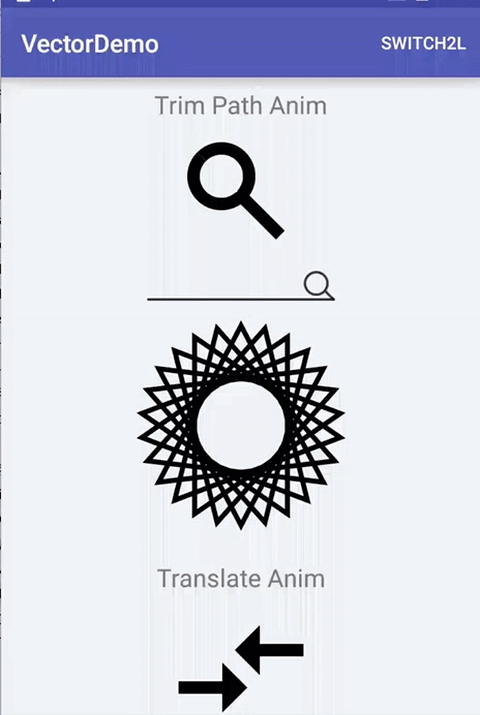
Vector性能问题
有读者在文章后面留言,询问VectorDrawable的性能问题,这里解释一下。
- Bitmap的绘制效率并不一定会比Vector高,它们有一定的平衡点,当Vector比较简单时,其效率是一定比Bitmap高的,所以,为了保证Vector的高效率,Vector需要更加简单,PathData更加标准、精简,当Vector图像变得非常复杂时,就需要使用Bitmap来代替了
- Vector适用于ICON、Button、ImageView的图标等小的ICON,或者是需要的动画效果,由于Bitmap在GPU中有缓存功能,而Vector并没有,所以Vector图像不能做频繁的重绘
- Vector图像过于复杂时,不仅仅要注意绘制效率,初始化效率也是需要考虑的重要因素
- SVG加载速度会快于PNG,但渲染速度会慢于PNG,毕竟PNG有硬件加速,但平均下来,加载速度的提升弥补了绘制的速度缺陷。
Google的这个视频中,已经对Vector的效率问题做了解释,可以参考下:
https://www.youtube.com/watch?v=wlFVIIstKmA&feature=youtu.be&t=6m3s
参考
https://medium.com/@shemag8/animated-vector-drawable-e4d7743d372c#.3vkt12j20
https://github.com/jpuderer/AnimatedButton
